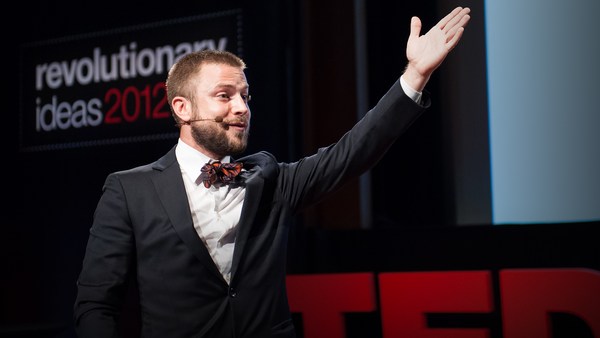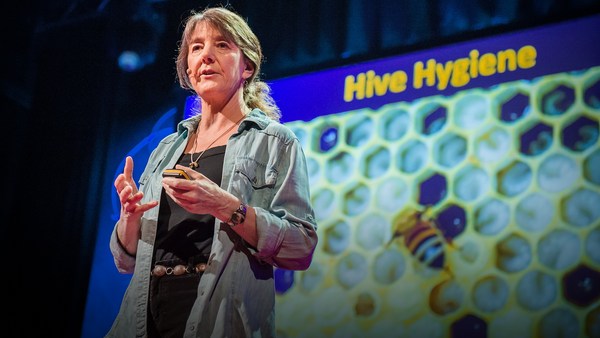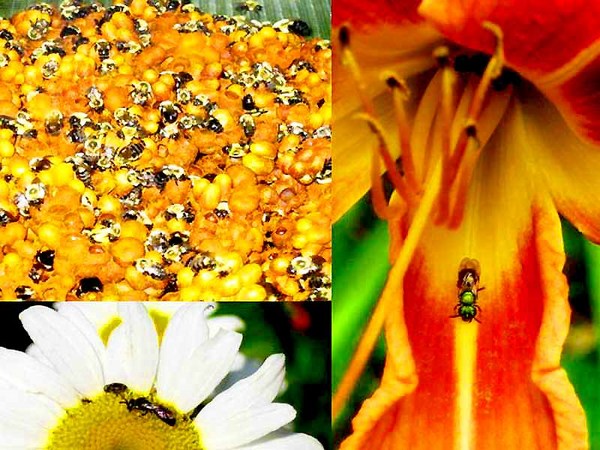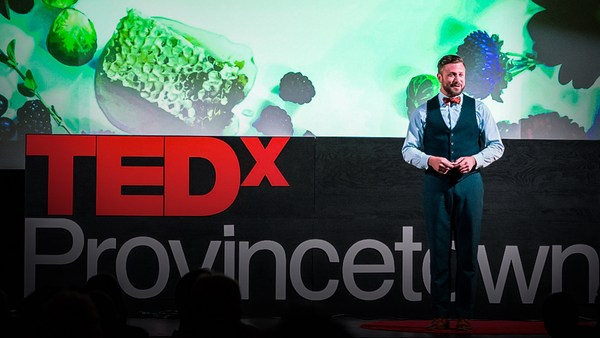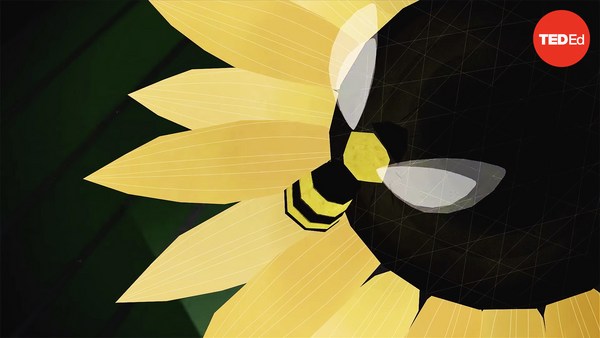Pollinator decline is a grand challenge in the modern world. Of the 200,000 species of pollinators, honeybees are the most well-understood, partly because of our long history with them, dating back 8,000 years ago to our cave drawings in what's now modern-day Spain, and yet, we know that this indicator species is dying off. Last year alone, we lost 40% of all beehives in the United States, and that number is even higher in areas with harsh winters, like here in Massachusetts, where we lost 47% of beehives in one year alone. Can you imagine if we lost half of our people last year? And if those were the food-producing people? And I predict that in 10 years, we will lose our bees. If not for the work of beekeepers replacing these dead beehives, we would be without foods that we rely upon: Fruits, vegetables, crunchy almonds and nuts, tart apples, sour lemons, even the food that our cattle relies upon to eat - hay and alfalfa, gone - causing global hunger, economic collapse, a total moral crisis across Earth. And it's going to take an effort from every single one of you here to become what we call "citizen scientists," to activate all the things that you're probably already doing - Yes, planting flowers, getting beehives, making bee hotels, habitats for those lesser known pollinators, but beyond that, going a step further, and adding a data collection element to it. So, I'm going to show you how to do this here today, and I'm going to show you how when my team shifted our perspective away from bees that were dying and toward maps and looking at hot spots for bee health, and shifting our perspective away from honey as just a sweet, sticky delicious food, but to a source of information that contains a blueprint for healthy habitat suspended in time in the only food that doesn't go bad. That's where we find the hope and that's what we'll do together today. Now, I first started keeping bees here in Cape Cod, right after I finished my doctorate in honeybee immunology. (Laughter) It was - (Applause) So, imagine getting such a degree in a good economy - (Laughter) And it was 2009 - the great recession. And I was onto something - I knew that I could find out how to improve bee health. And that's when word started to spread and I came here to Cape Cod and I realized that this deep connection that people have to the land here is so true and long-standing - probably because there's so little of the land that is here, we're connected to it. And so the community on Cape Cod, here in Provincetown, was right for citizen science, people looking for ways to get involved and to help. And so, we met with people in coffee shops. A wonderful woman named Natalie got eight beehives at her home in Truro, and she introduced us to her friend Valerie, who let us set up 60 beehives at an abandoned tennis court on her property. And so we started testing vaccines for bees. We were starting to look at probiotics. We called it bee yogurt. Ways to make bees healthier. And our citizen science project started to take off. Word started to spread and people started to think, "Wow, I can get bees of my own and their little data factory, that's great!" Meanwhile, back in my apartment here, I was a bit nervous about my landlord. I figured I should tell him what we were doing. (Laughter) I was terrified. I really thought I was going to get an eviction notice which really was the last thing we needed, right? I must have caught him on a good day, though, because when I told him what we were doing and how we started our non-profit urban beekeeping laboratory, he said, "That's great! Let's get a beehive in the back alley." I was shocked! I was completely surprised. I mean, instead of getting an eviction notice, we got another data point. And in the back alley of this image, what you see here, this hidden beehive, that beehive produced more honey that first year than we had ever experienced in any beehive we had managed. Over a hundred pounds of honey that one year alone. We didn't know what to do with it. I mean, we were filling up pickle jars with the stuff. And since honey is the only food that never goes bad, the residents and tenants in the community are still enjoying that honey today. It shifted our research perspective forever. It changed our research question away from how do we save the dead and dying bees to where are bees doing best. And we started to be able to put maps together, looking at all of these citizen science beehives from people who had beehives at home decks, gardens, business rooftops. And we started to engage the public, and the more people who got these little data points, the more accurate our maps became. And so when you're sitting here thinking, "How can I get involved?", you might think about the story of my friend Fred, who's a commercial real estate developer and he was thinking the same thing. But even if you own a business, you can be a citizen scientist too. He was at a meeting thinking about what he could do for tenant relations and sustainability at scale. And while he was having a tea break, he put honey into his tea and noticed, on the honey jar, a message about corporate sustainability from the host company of that meeting and it sparked an idea. He came back to his office, an email, a phone call later, and boom! We went national together. We put dozens of beehives on the rooftops of their skyscrapers across nine cities nationwide. Nine years later - (Applause) Nine years later we have raised over a million dollars for bee research. We have a thousand beehives as little data points across the country, 18 states and counting, where we have created paying jobs for local beekeepers - 65 of them - to manage beehives in their own communities, to connect with people, everyday people who are now data points, together, making a difference. So, in order to explain what's actually been saving bees, where they're thriving, I need to first tell you what's been killing them. The top three killers of bees are agricultural chemicals, such as pesticides, herbicides, fungicides; diseases of bees, of which there are many; and habitat loss. So, what we did is we looked at our maps and we identified areas where bees were thriving, and this was mostly in cities, we found. Data are now showing that urban beehives produce more honey than rural beehives and suburban beehives. Urban beehives have a longer lifespan than rural and suburban beehives. And bees in the city are more biodiverse; there are more bee species in urban areas. (Laughter) Right? "Why is this?" That was our question. So, we started with these 3 killers of bees and we flipped it. Which of these is different in the cities? So, the first one: Pesticides. We partnered up with the Harvard School of Public Health. We shared our data with them, we collected samples from our citizen science beehives at people's homes and business rooftops. And we looked at pesticides levels and we thought there'd be less pesticides in areas where bees are doing better. That's not the case. What we found here in our study is that the orange bars are Boston, and we thought those bars would be the lowest, there would be the lowest level of pesticides and, in fact, there are the most pesticides in the cities. So, the pesticide hypothesis for what saving bees,
less pesticides in cities, is not it. And this is very typical of my life as a scientist. Any time I've had a hypothesis, not only is it not supported, but the opposite is true. (Laughter) Which is still an interesting finding, right? We moved on. The disease hypothesis. We looked at diseases all over our beehives and what we found in similar study to this one with the North Carolina State: There's no difference between disease and bees in urban, suburban and rural areas, diseases are everywhere; bees are sick and dying. In fact, there were more diseases of bees in cities. This was from Raleigh, North Carolina. So again, my hypothesis was not supported, the opposite was true. We're moving on. (Laughter) The habitat hypothesis. This said that areas where bees are thriving have a better habitat. More flowers, right? But we didn't know how to test this. So, I had a really interesting meeting and an idea sparked with my friend and colleague, Anne Madden, fellow TED speaker, and we thought about genomics, kind of like AncestryDNA or 23andMe - Have you done these? You know, you spit in the tube and you find out, "I'm German," right? (Laughter) We developed this for honey, right? And so we have a sample of honey and we look at all the plant DNA and we find out, "I'm Sumac." (Laughter) And that's what we found here in Provincetown, and so, for the first time ever I'm able to report to you what type of honey is from right here in our own community. Honey DNA, a genomics test. Spring honey in Provincetown is from Privet. What's Privet? Hedges. What's the message? Don't trim your hedges to save the bees. (Laughter) Right? I know we're getting crunchy here, and it's controversial, so before you throw your tomatoes, let's move to the summer honey, which is water-lily honey. If you have honey from Provincetown, right here in the summer, you're eating water-lily juice. In the fall, sumac honey. We're learning about our food for the first time ever and now we are able to report, if you need to do any city planning, what are good things to plant, what do we know the bees are going to that's good for your garden. What's more interesting for us is deeper in the data. So, if you are from the Caribbean and you want to explore your heritage - Bahamian honey is from the Laurel family; cinnamon and avocado flavors.
But what's more interesting is 85 different plant species in one teaspoon of honey. That's the measure that we want. The big data. Indian honey. That is oak. Every sample we tested from India is oak and that's a 172 different flavours in one taste of Indian honey. Provincetown honey goes from a 116 plants in the spring to over 200 plants in the summer. These are the numbers that we need to test the habitat hypothesis in another citizen science approach. You find out about your food and we get some interesting data. So, we're finding out now that in rural areas there are a 150 plants on average in a sample of honey. That's a measure for rural. Suburban areas, what might you think? Do they have less or more plants in suburban areas with lawns - that look nice for people but they're terrible for pollinators? Suburbs have very low plant diversity, so if you have a beautiful lawn, well, good for you, but you can do more. You can have a patch of your lawn that's a wildflower medow to diversify your habitat to improve pollinator health. Anybody can do this. Urban areas have the most habitat. The best habitat they have - As you can see here, over 200 different plants. We have, for the first time ever, support for the habitat hypothesis. We also now know how we can work with cities. The city of Boston has eight times better habitat than its nearby suburbs. And so when we work with governments, we can scale this. You might think on my tombstone it'll say, "Here lies Noah, plant a flower," right? (Laughter) It's exhausting after all of this, right? But when we scale together, when we go to governments and city planners - Like, in Boston, the honey is mostly Linden trees, and we say, "If a dead tree needs to be replaced, consider Linden." So, when we take this information to governments, we can do amazing things. This is a rooftop from Fred's company. We can plant those things on top of rooftops worldwide to start restoring habitat and securing food systems. We've worked with the World Bank, and the presidential delegation from the country of Haiti. We've worked with wonderful graduate students at Yale University in Ethiopia, and in these countries we can add value to their honey by identifying what it is, but informing the people of what to plant to restore their habitats and secure their food systems. But what I think is even more important is when we think about natural disasters. For the first time, we now know how we can have a baseline measure of any habitat before it might be destroyed. Think about your hometown. What risks does the environment pose to it? This is how we're going to save Puerto Rico after Hurricane Maria. We now have a baseline measure of honey, honey DNA from before and after the storm. We started in Humacao. This is right where Hurricane Maria made landfall. And we know what plants to replace, and in what quantity and where, by triangulating honey DNA samples. You might even think about right here, the beautiful land that connected us, that primed all the citizen science to begin with. The erosion, the winter storms that are getting more violent every year. What are we going to do about this, our precious land? While looking at honey DNA, we can see what plants are good for pollinators that have deep roots that can secure the land. And together, everybody can participate and the solution fits in a teaspoon. If your hometown might get swept away or destroyed by a natural disaster, we now have a blueprint suspended in time for how to restore that on Earth, or perhaps even in a greenhouse on Mars. I know it sounds crazy, but think about this, a new Provincetown, a new hometown, a place that might be familiar that's also good for pollinators for a stable food system, when we're thinking about the future. Now, together we know what's saving bees: By planting diverse habitats. We know how bees are going to save us: By being barometers for environmental health, by being blueprints, sources of information, little data factories, suspended in time. And now you all know exactly what you can do as citizen scientists to get beehives. Thank you. (Applause)
